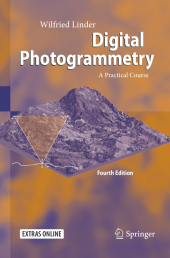 Neuerscheinungen 2018Stand: 2020-02-01 |
Schnellsuche
ISBN/Stichwort/Autor
|
Herderstraße 10
10625 Berlin
Tel.: 030 315 714 16
Fax 030 315 714 14
info@buchspektrum.de |

Wilfried Linder
Digital Photogrammetry
A Practical Course
4. Aufl. 2018. xxiii, 209 S. 76 SW-Abb. 235 mm
Verlag/Jahr: SPRINGER, BERLIN; SPRINGER BERLIN HEIDELBERG 2018
ISBN: 3-662-57063-7 (3662570637)
Neue ISBN: 978-3-662-57063-0 (9783662570630)
Preis und Lieferzeit: Bitte klicken
With several tutorials of increasing complexity, accompanied by texts explaining further theory, this third edition is an "all-in-one" combination of basic theory and practical exercises on digital photogrammetry.
The fourth edition is again an "all-in-one" combination of basic theory and practical exercises with software and data available from the Springer server. Potential readers / users are students of Photogrammetry, Geodesy, Geography and other sciences, but also all who are interested in this topic. No prior knowledge is necessary, except the handling of standard PCs. Theory is presented true to the motto "as little as possible, but as much as necessary".
The main part of the book contains several tutorials. In increasing complexity, accompanied by texts explaining further theory, the reader can proceed step by step through the particular working parts. All intermediate as well as the final results are discussed with reference to accuracy and error handling, and included in the data sets to provide controls. Most of the standard work in Digital Photogrammetry is shown and trained, for example scanning, image orientation, stereo plotting, aerial triangulation measurement (manual and automatic), block adjustment, automatic creation of surface models via image matching, creation of ortho images and mosaics, and others. Examples of both aerial and close-range photogrammetry present the power of this kind of measurement techniques. 3-D images can be viewed with the accompanying 3-D glasses.
During the time since the last edition, the software development went on, and therefore it was necessary to adopt the text to the actual program versions which were also tested to work properly under MS Windows 10. Few options which are obsolete nowadays were removed, some new options were added, the handling of the software was simplified in several places, and so on. For the use of own images taken with a custom digital camera, a new chapter offers an easy way of lens calibration and explains how to get good results with a minimum of work.
The software is not limited to the example data included but may be used for personal projects. Part of the book comprises a complete description of the software.
.


